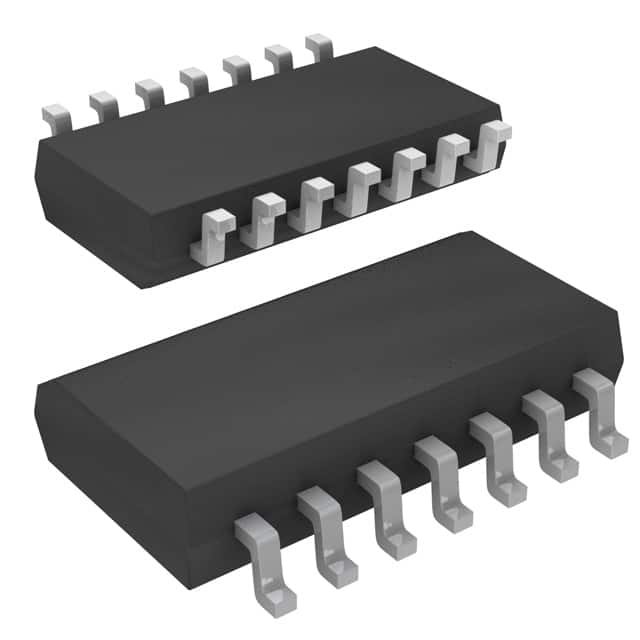Consulte las especificaciones para obtener detalles del producto.

SN74LVC125ANSR
Product Overview
- Category: Integrated Circuit (IC)
- Use: Buffer/Driver
- Characteristics: Low Voltage, Quad Bus Buffer with 3-State Outputs
- Package: SOIC (Small Outline Integrated Circuit)
- Essence: This IC is designed to provide buffering and driving capabilities for digital signals in low voltage applications.
- Packaging/Quantity: Available in tape and reel packaging, with a quantity of 2500 units per reel.
Specifications
- Supply Voltage Range: 1.65V to 5.5V
- Input Voltage Range: 0V to VCC
- Output Voltage Range: 0V to VCC
- Maximum Operating Frequency: 80MHz
- Number of Channels: 4
- Output Current: ±24mA
- Propagation Delay: 2.8ns (typical)
Detailed Pin Configuration
The SN74LVC125ANSR has a total of 14 pins, which are assigned as follows:
- OE (Output Enable) - Active LOW output enable input
- Y1 - Output 1
- A1 - Input 1
- GND - Ground
- A2 - Input 2
- Y2 - Output 2
- A3 - Input 3
- VCC - Power supply
- Y3 - Output 3
- A4 - Input 4
- Y4 - Output 4
- GND - Ground
- NC (No Connection) - Not connected
- OE (Output Enable) - Active LOW output enable input
Functional Features
- Low voltage operation allows compatibility with a wide range of systems.
- 3-state outputs provide flexibility in controlling the bus lines.
- High-speed operation enables efficient data transfer.
- Schmitt-trigger inputs ensure noise immunity.
- ESD protection guards against electrostatic discharge.
Advantages and Disadvantages
Advantages: - Wide supply voltage range allows for versatile applications. - 3-state outputs enable bus sharing and reduce conflicts. - High-speed operation enhances system performance. - Schmitt-trigger inputs provide robustness against noise.
Disadvantages: - Limited output current may restrict use in certain high-power applications. - Propagation delay may affect timing-sensitive systems.
Working Principles
The SN74LVC125ANSR operates as a buffer/driver, taking digital input signals and providing amplified output signals. When the OE (Output Enable) pin is low, the outputs are enabled and reflect the input values. Conversely, when the OE pin is high, the outputs are disabled and enter a high-impedance state, allowing other devices to drive the bus lines.
The IC operates within a specified supply voltage range and provides 3-state outputs, which can be used to control the direction of data flow or to share a bus among multiple devices. The Schmitt-trigger inputs ensure reliable signal reception by reducing the effects of noise.
Detailed Application Field Plans
The SN74LVC125ANSR finds applications in various fields, including:
- Microcontrollers: Used to interface microcontrollers with external devices, such as sensors, displays, and memory modules.
- Communication Systems: Employed in signal buffering and level shifting circuits in communication systems, ensuring proper signal transmission between different components.
- Industrial Automation: Integrated into control systems to buffer and drive digital signals in industrial automation equipment, such as PLCs (Programmable Logic Controllers).
- Automotive Electronics: Utilized in automotive electronics for signal conditioning and driving tasks, enabling reliable communication between different vehicle subsystems.
- Consumer Electronics: Incorporated into consumer electronic devices, such as smartphones, tablets, and gaming consoles, to facilitate signal amplification and level shifting.
Detailed and Complete Alternative Models
- SN74LVC126A: Similar to SN74LVC125ANSR, but with 3-state outputs and an additional input enable pin.
- SN74LVC244A: Octal buffer/driver IC with 3-state outputs, suitable for bus driving applications.
- SN74LVC1G125: Single-channel buffer/driver IC with 3-state output, designed for low-voltage applications.
These alternative models offer similar functionality and can be considered as substitutes for the SN74LVC125ANSR in various applications.
Word count: 526 words
Enumere 10 preguntas y respuestas comunes relacionadas con la aplicación de SN74LVC125ANSR en soluciones técnicas
Sure! Here are 10 common questions and answers related to the application of SN74LVC125ANSR:
Q: What is SN74LVC125ANSR? A: SN74LVC125ANSR is a quad bus buffer gate with 3-state outputs, commonly used in digital logic applications.
Q: What is the operating voltage range for SN74LVC125ANSR? A: The operating voltage range for SN74LVC125ANSR is typically between 1.65V and 5.5V.
Q: What is the maximum output current that SN74LVC125ANSR can drive? A: SN74LVC125ANSR can drive up to 32mA of output current per channel.
Q: Can SN74LVC125ANSR be used as a level shifter? A: Yes, SN74LVC125ANSR can be used as a level shifter to convert signals between different voltage levels.
Q: How many channels does SN74LVC125ANSR have? A: SN74LVC125ANSR has four independent channels, each with its own input and output.
Q: What is the purpose of the 3-state outputs in SN74LVC125ANSR? A: The 3-state outputs allow the outputs to be disabled or put into a high-impedance state, which is useful for bus sharing applications.
Q: Can SN74LVC125ANSR be used in high-speed applications? A: Yes, SN74LVC125ANSR is designed for high-speed operation and can be used in applications with fast switching speeds.
Q: Is SN74LVC125ANSR compatible with both CMOS and TTL logic levels? A: Yes, SN74LVC125ANSR is compatible with both CMOS and TTL logic levels, making it versatile for various applications.
Q: What is the typical propagation delay of SN74LVC125ANSR? A: The typical propagation delay of SN74LVC125ANSR is around 4.3ns.
Q: Can SN74LVC125ANSR be used in automotive applications? A: Yes, SN74LVC125ANSR is qualified for automotive applications and can operate in harsh environments within specified temperature ranges.
Please note that these answers are general and may vary depending on specific datasheet specifications and application requirements.

